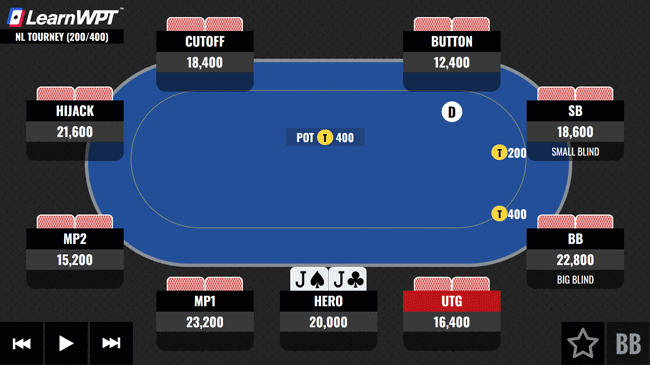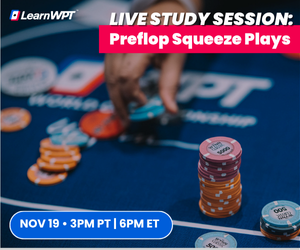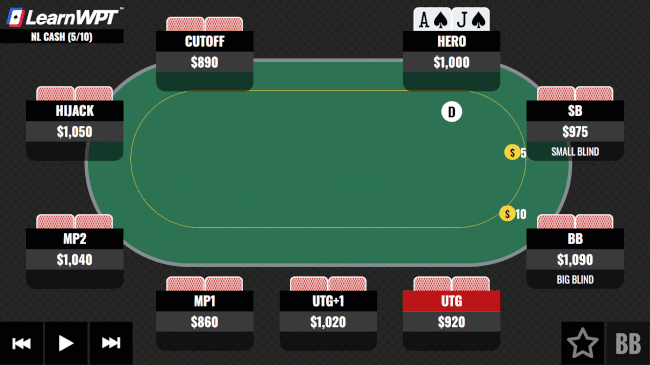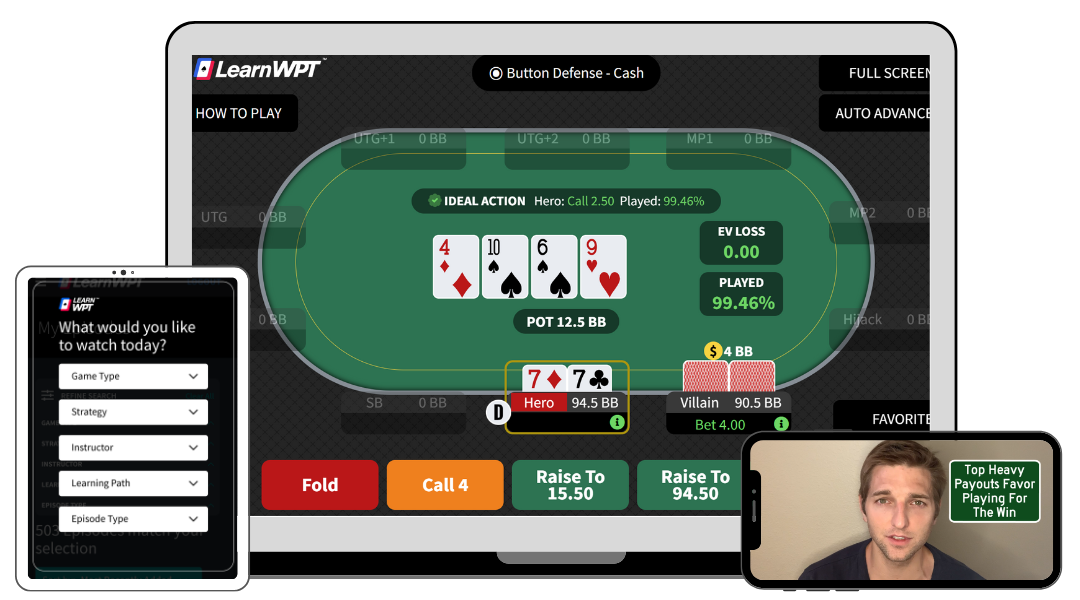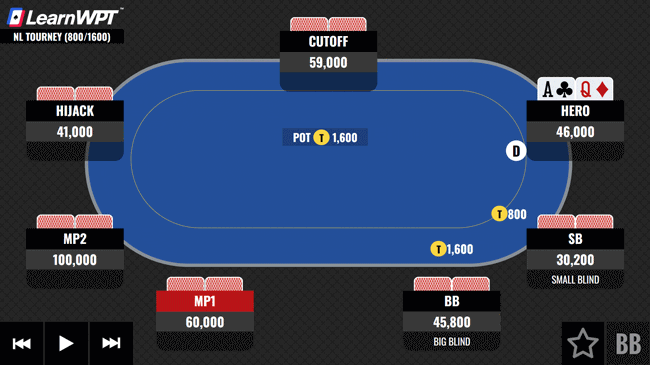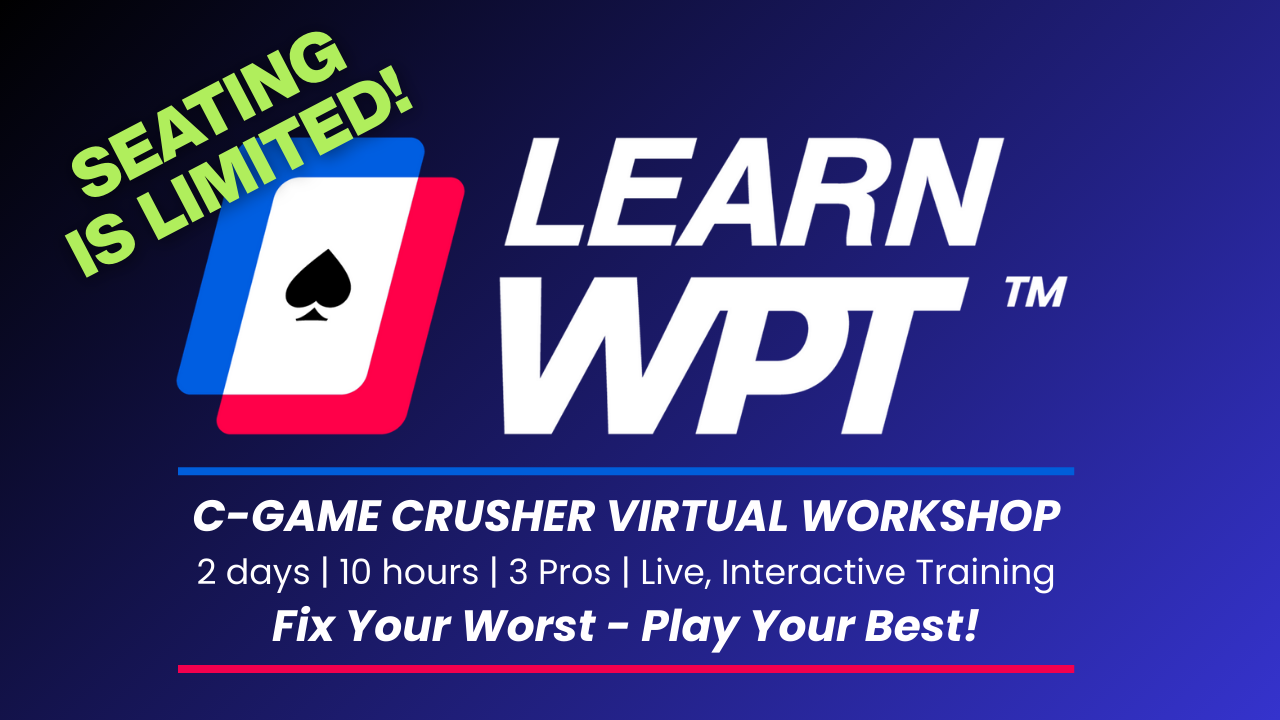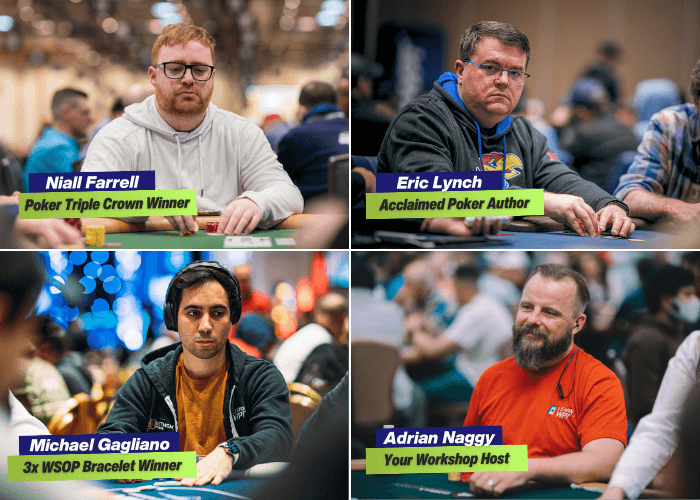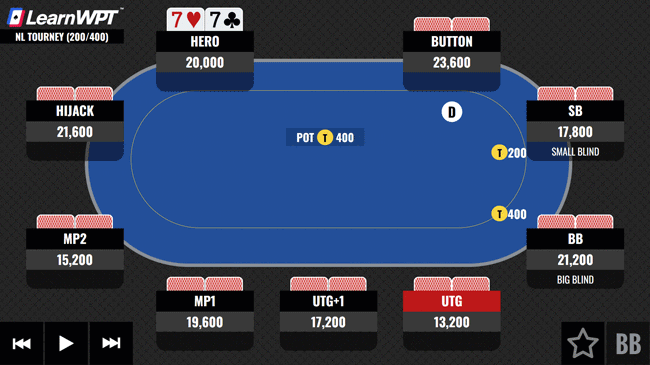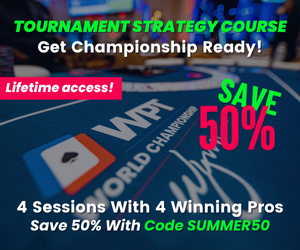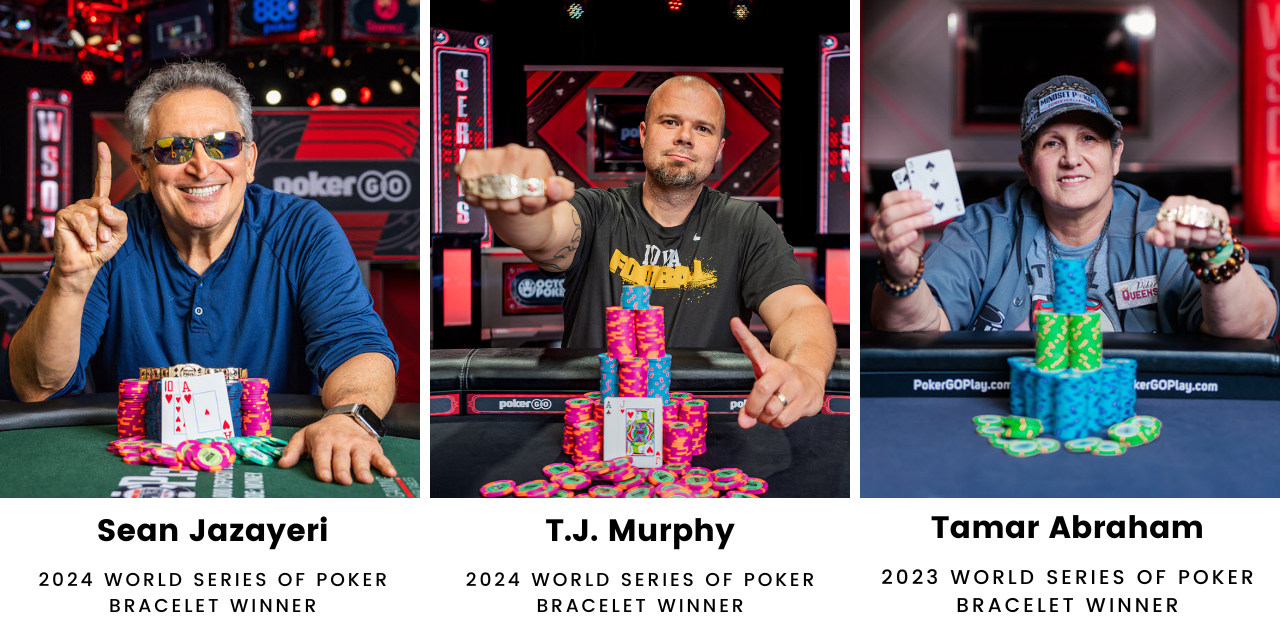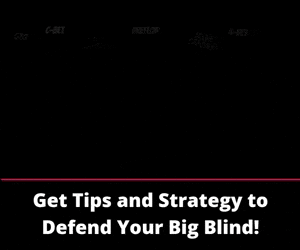Poker Quiz! In Early Position With J♠J♣ Vs a GTO-Style Pro...
DECISION POINT: You’re playing in a big regional tournament series with a mix of locals and traveling professional players. The blinds are 200/400 with a 400 big blind ante and you have 20,000 chips to start the hand. From Under the Gun you raise to 1,000 with J♠J♣ and it folds around to the Big Blind, who is a pro known for their GTO-style play, and they just call. Your opponent checks the Q♣8♥8♦ flop and action is on you. What do you do here?
PRO ANSWER: We are playing in a bigger regional tournament series with a mix of locals and traveling professional players. The tournament is still in the early stages, with 200/400 blinds and a 400 big blind ante. The player in the Big Blind is a traveling professional known for GTO-style play. We are UTG+1 and have 20,000 chips to start the hand.
The UTG player folds, and we look down at J♠J♣ and elect to make a standard first-in raise to 1,000. Our remaining opponents fold except for the Big Blind, who flat calls with just over 22,000 chips behind. The flop is Q♣8♥8♦ and the Big Blind checks.
When deciding if we should continuation bet or not, the focus should start on how our range and our opponent’s range interact. As an early position raiser, our range doesn’t contain a lot of 8x combos, while the Big Blind is calling with a wide range that contains many more 8x hands. We do have some over pairs and some strong Qx hands, however it’s much harder for us to have connected strongly with this particular board than it is for our opponent.
The Big Blind’s range still has a lot of random hands that haven’t connected with this board in any meaningful way. Given that our opponent utilizes GTO strategy we can reasonably assume they will be aware of the huge difference between the two ranges and adjust by check-raising a variety of hands that includes some 8x plus a fair amount of bluff combos with some sort of backdoor equity.
Continued below...
Since our ranges interact in this awkward way, a polarized continuation betting strategy is preferred. This will allow us to keep bluffs in our range that benefit when the Big Blind is forced to fold hands that completely miss the flop, along with strong hands that can withstand the inevitable check-raises that come with some frequency from our GTO-style opponent.
Since pocket jacks don’t get much benefit from making many of the complete misses in our opponent’s range fold, JJ becomes a great candidate to check behind against this kind of opponent. In fact, JJ benefits a lot when the Big Blind calls with hands such as 64s that they would normally fold to a continuation bet but would potentially use as a low-equity bluff candidate on the turn.
If we are playing an opponent who is either incapable of check-raise bluffing with appropriate frequency or plays extremely fit-or-fold, we can continuation bet more frequently. However, against a GTO-style player we will get check-raised and be forced to fold our hand far too often to make continuation betting the best play.
Checking is the best play.
How would you play it?
Share your answer in the comments below!
Improve Your Game Today!
Join LearnWPT and Get:
- The WPT GTO Trainer to play real solved hands and get instant feedback on YOUR leaks (over 4 BILLION solved spots!)
- On-demand access to our full library of 500+ (and growing) in-depth Strategy Episodes from world-class players
- All of your poker questions answered with the Ask a Pro Feature
- Expert analysis from LearnWPT Pros using The Hand Input Tool
- Downloadable Tools you can use at and away from the tables
- Learn from a Team of world-class Professional Players
To join (just $5 your 1st month) click the JOIN NOW button and start improving your game!
Have Questions about LearnWPT? Email us at [email protected].
Poker Quiz! Pocket Eights Facing an All-In, What Do You Do Here?
DECISION POINT: In an online Tournament with blinds at 500/1,000 and a 1,000 big blind ante you are dealt 8♣8♠ in the Cutoff seat. Stacks at the table range from 10BBs to just over 40BBs. The early position players fold, the MP1 player open shoves for 15,000 (15BBs) and action is on you with 21BBs behind.
What do you do here?
PRO ANSWER: We are in the middle stages of a major Sunday online tournament. The blinds are 500/1,000 with a 1,000 big blind ante. The stacks range from 10 big blinds to just over 40. We are dealt black eights in the cutoff and it folds to MP1 who open shoves for 15,000.! Everyone else folds and action is on us.
When analyzing spots like this after the fact, we should approach from two perspectives. First, we should estimate MP1 range and how our hand performs against that range, much like we would in real-time at the table. Second, we should double check our estimate in real-time by running the spot in a solver to see what things look like when both players are using optimal ranges.
Studying in this way allows us to exercise our brain in the same way that we will use at the table, and then either reinforce our thoughts with the solver or discover any errors.
If the decision was wrong in real-time we can determine if this is a fundamental leak and what adjustments need to be incorporated to our game plan. If the opponent was likely shoving different ranges than the solvers suggest which may often be the case, then we can consider the merits of making an exploitative adjustment against our real life foes.
A primary consideration is whether MP1 has a non all-in raising range here. It’s likely at this stack size that they would raise a more standard sizing and not just move all-in with AA/KK and some of their other biggest hands.
Continued below...
Given this we can assume that MP1 is likely to have a capped range that includes many suited broadway hands, some big Ax hands, and some middle pairs. The key factor we need to assess is if MP1 will ever move all-in with pocket pairs lower than 88 or Ax combinations where their kicker is lower than 8.
In real-time we thought it was possible our opponent is capable of shoving as light as 77, but 66 or less and A8s or worse seemed unlikely so we chose to fold.
Through post hand analysis using a Game Theory Optimal Solver we can see that if MP1 is splitting their range properly the all-in range will include 66-99, A8s-AJs, AKo, KJs, KTs, QTs+. The range of hands that prefers to raise a standard amount first-in at 15BB blinds includes a mix of stronger hands (TT+/AQs+), some smaller suited Ax combinations, and offsuit broadway hands. Against the specific all-in range provided by the Solver we see that 88 has a +550 chip (+.55 BB) expectation. This means that against an opponent using GTO ranges we should be calling, although the decision is still very close.
In real world situations many players might shove hands such as TT/JJ, especially as they don’t want to encourage action and have to play postflop. If MP1 was the type of opponent to use this larger sizing with medium pairs that may be vulnerable on overcard flops then this spot would quickly become a fold. We would also have an easier call if we were in the Blinds with fewer players behind yet to act.
Against a GTO opponent, calling is the best play. Against specific opponents shoving narrower ranges or higher pairs, you could make an exploitative fold.
How would you play it?
Share your answer in the comments below!
Train ➧ Play ➧ Think ➧ Like a Pro
We created LearnWPT with the goal to provide a place that empowers players to ask questions, help get them focused, and provide a solid game-plan to bring to the table every time they sit down.
Some of the ways we accomplish this is by:
- Teaching and presenting examples of proven, winning concepts through our Strategy Episodes (short 10-15 min videos)
- Having Members Practice, Drill, and Play Hands using the WPT GTO Trainer for instant feedback on their decisions
- Providing a place where Members can send questions to receive answers and guidance with the Ask a Pro Forums
- Giving Members the ability to record and send hands they've played to receive expert analysis using the Hand Input Tool
Not a Member? Join today for just $5 your first month and start improving your game!
Poker Quiz! In a 3-Bet Pot With A♠J♠ Facing a C-Bet, Your Move?
DECISION POINT: You are about 20 minutes into a live $5/$10 cash game session where most of the stacks are around 100 big blinds and you have $1,000. Action folds to you on the Button and you make the table standard raise to $30 with A♠J♠. The Small Blind folds, the Big Blind 3-bets to $120, you call. Your opponent bets $120 on the A♥7♠2♠ flop and action is on you. What do you do here?
PRO ANSWER: We’ve just recently joined a 9-handed $5/$10 cash game. Most stacks are around 100 big blinds and we start the hand with $1,000 and A♠J♠ on the Button. Action folds around to us, and with AsJs we have a hand that is certainly strong enough to open with first-in to the pot from the Button, so we make the standard table raise to $30. The Small Blind folds and the Big Blind 3-bets to $120.
When the Big Blind 3-bets, they are representing a very polarized range. This is especially true as the Big Blind is in a favorable spot to call with many hands since they are getting a great price to call and are guaranteed to see a flop as the last player to close the action preflop. Our specific hand AJs is strong enough to continue with, however not strong enough that we want to 4-bet.
We call and the flop comes A♥7♠2♠. This is about the best flop possible when we make only 1-pair in this scenario. If the Ah were the Jh we might feel slightly more confident in this spot since the Big Blind's 3-betting range has many more Ax hands than Jx, however we are still pretty happy on this Ace high flop with 2 low cards.
Our opponent comes out firing, making it $120.
Continued below...
The first step in deciding our best approach to this c-bet is to consider the Big Blind’s likely range. We can assume they 3-bet preflop with a range including a lot of big Ax hands, some bigger pocket pairs, plus some smaller portion of suited connectors and other hands to balance out their polarized preflop range. This is a very tempting spot to raise, and doing so certainly is +EV.
However, taking a closer look at the Big Blind’s range we can assume if we raise they are likely to only continue with the Ax hands that have us outkicked, or hands such as 77/A7s. We have very little reason to protect ourselves against the Big Blind's TT-KK type holdings, and if they have complete air we would welcome them to continue bluffing on future streets. Continuing by calling allows us to keep weaker hands in the Big Blind’s range that might continue to bluff, and gives us a great price to draw when we are behind.
While we might be faced with some trickier turn and river decisions when we call and don’t improve, calling will maximize our expected value against their entire range.
Calling is the best play.
How would you play it?
Share your answer in the comments below!
Start Playing Better Poker With LearnWPT
Whether you’re brand-new to poker training or are an experienced student, a Membership to LearnWPT.com is your chance to learn from world-class professional poker players in a friendly community using state-of-the-art tools.
Join now to get started, and you'll immediately gain access to the LearnWPT training features, including WPT GTO Trainer packs, 550+ strategy videos, downloadable tools, Ask a Pro Discord, and more!
Have Questions about LearnWPT? Send an email to our Support Team at [email protected] or click the red CONTACT US button.
Poker Quiz! What's Your Move Here With A♣Q♦ Vs Loose Regs?
DECISION POINT: You’re playing a local daily tournament with a table full of regulars. Action folds to a player in MP2 who often limps to see flops but plays preflop fairly straightforwardly, and they limp again. It folds to you on the Button, and you raise to 5,600 with A♣Q♦. The Small Blind, an active player who likes to splash around but plays postflop well, calls. The Big Blind folds and MP2 calls. The flop comes T♥5♠2♣ and both opponents check.
Action is on you, what's your move here?
PRO ANSWER: We are playing a local daily tournament with many familiar faces. The blinds are 800/1,600 with a 1,600 big blind ante. We recognize the player in MP2 as being a very loose player who likes to limp preflop and see flops, but tends to play relatively straightforward postflop. The Small Blind is another player who likes to splash around a lot, however they are extremely tricky postflop often trying to make up for a wide preflop calling range by winning more than their fair share of pots postflop.
We are dealt A♣Q♦ on the Button and it folds to the MP2 player who limps. Everyone else folds to us. This is a great spot for us to isolate a wide open limper while in position with a hand that figures to be well ahead of MP2’s range. The default bet size is 4,800 at this stack depth to isolate the limper, but with the splashy player in the Small Blind we elect to make it 5,800 in an attempt to shut them out of the pot. The Small Blind still decides to call and MP2 calls as well.
The flop is T♥5♠2♣ and both players check to us. It can be tough to put both our opponents on accurate ranges since we’ve observed they both can call quite wide preflop. One question that is fairly easy for us to answer is what our opponents are unlikely to have. If either MP2 or the Small Blind had big cards like AK/AQ or big pairs such as JJ+ they likely wouldn’t have just called preflop. This condenses both our opponents ranges to have a lot more small to mid pairs and middling connected and/or suited cards. Those types of hands connect very well with this board.
We could potentially go with a plan of betting here and just going with it against the tricky Small Blind who is relatively short, figuring we have more than enough equity against them and then folding if MP2 continues knowing they play straightforwardly. If this were a cash game, that might be a profitable plan. However in tournaments, ICM makes it so that the chips we win are worth less on average, than the chips we are risking. That makes betting in this spot less appealing.
If we choose to check we're going to get a lot of information on the turn. Ace high is rarely the best hand 3-ways, but any queen or ace likely gives us the best hand and any three, four, jack, or king also gives us an inside straight draw. In addition, with this configuration it is highly likely that when action checks through on the flop the Small Blind will stab with a very wide range on the turn and the player in MP2 will react very honestly with their hand. When MP2 folds to the turn lead we may often be able to continue against the Small Blind’s stabbing range. In the instances when MP2 calls we can often safely get out of the way, assuming we didn’t turn an ace or a queen or are getting proper pot odds with a draw plus overcards.
This is a dry board that can be very tempting to continuation bet into two players. With the given player configurations and tendencies however, it is unlikely to work the required amount of the time to be profitable. Additionally, checking against this specific player configuration will give us loads of additional information on the turn to make far better decisions.
Checking is the best play.
How would you play it?
Share your answer in the comments below!
LAST CHANCE! 2-Day Live Virtual Workshop
Join Team LearnWPT for our upcoming 2-Day C-Game Crusher Live Virtual Strategy Workshop - all from the comfort of home!
If you’re tired of repeating the same mistakes and hitting the same plateaus, it’s time to train differently. Join us this September to reset your approach, sharpen your game, and play your best poker.
Hurry... Registration ends Thursday, September 18th
The LearnWPT C-Game Crusher Workshop features two (2) Live Virtual Sessions on Saturday, September 20th and September 27th, giving you the power to elevate your game without leaving home. Each Session is expertly structured to deliver maximum impact, packing 5 immersive hours of world-class instruction into every session.
You’ll train directly with elite poker minds including poker Triple Crown winner Niall Farrell, 3x WSOP bracelet winner Michael Gagliano, and acclaimed author and teacher Eric Lynch!
Have Questions about this event? Send an email to our Support Team at [email protected] or click the red CONTACT US button.
Poker Quiz! In Late Position With 7♥7♣ Vs the Big Blind...
DECISION POINT: You are in the early stages of a daily tournament and you don’t have any significant reads on your tablemates, with the exception that most have been showing down reasonable hands. The blinds are 200/400 with a 400 big blind ante and you have 20,000 chips to start the hand. The action folds to you in the Cutoff with 7♥7♣, you open to 1,000, and only the Big Blind calls. Your opponent checks the K♣5♥2♦ flop, you c-bet 900, and they call. On the 3♣ turn, the Big Blind leads out for 1,500. Action is on you — what do you do here?
PRO ANSWER: We are in the earlier stages of a daily tournament with blinds of 200/400 and a 400 big blind ante. Most of the players have been showing down reasonable hands when we’ve had the opportunity to see them, and we haven’t developed any significant reads to this point in the session.
With 20,000 chips to start the hand in the Cutoff and 7♥7♣ we make a standard raise to 1,000 chips, and everyone folds to the Big Blind who just calls. The flop is K♣5♥2♦ and the Big Blind checks to us. This is a board where the preflop raiser from the Cutoff will have a significant range advantage and we will frequently continuation bet with our entire range. In game we make the preferred choice and bet 900 into the 2,600 pot, and the Big Blind just calls.
The turn is the 3♣ and surprisingly, our opponent leads for 1,500. When an opponent takes a line where they lead into the aggressor on the turn, there are often one of several factors at play.
First, the Big Blind will often lead the turn when picking up additional equity, which in this case would mostly be flush draws but does include some Ax, 6x, and 4x hands.
Continued below...
Second, they could have turned two-pair or better with hands including A4, K3, 33, 53, and 32s, and are trying to build a pot fearing we may not fire again on this board texture. Lastly, this turn lead may be intended to to deny equity since we are betting such a wide range on the flop. Many of the 5x combos in the Big Blind’s range benefit greatly from generating folds from some of our random overcards such QJo that still have significant equity.
Given these assumptions, the Big Blind’s leading range likely consists of some draws, some bigger hands, and some medium-strength hands looking to clear out equity. Our pocket sevens are doing fairly well against that range. However, there is little reason to raise as our opponent is likely to fold medium-strength hands we dominate, continue with the hands that dominate us, and proceed with draws only if getting the correct price.
Calling is the best play.
How would you play it?
Share your answer in the comments below!
Improve Your Game Today!
Join LearnWPT and Get:
- The WPT GTO Trainer to play real solved hands and get instant feedback on YOUR leaks (over 4 BILLION solved spots!)
- On-demand access to our full library of 500+ (and growing) in-depth Strategy Episodes from world-class players
- All of your poker questions answered with the Ask a Pro Feature
- Expert analysis from LearnWPT Pros using The Hand Input Tool
- Downloadable Tools you can use at and away from the tables
- Learn from a Team of world-class Professional Players
To join (just $5 your 1st month) click the JOIN NOW button and start improving your game!
Have Questions about LearnWPT? Email us at [email protected].
Poker Quiz! At the WSOP With A♠T♠ vs a Pro, What Do You Do?
DECISION POINT: You are in the early stages of a multi-day tournament at the World Series of Poker with late registration and reentry still available. Most players have around 50 big blinds but you’ve worked your stack up to 100BBs. The action folds around to you in the Cutoff with A♠T♠ and you make a standard raise to 1,000. The Button, who is an accomplished Pro and has a 105BB stack, calls and the Blinds fold. The flop comes Q♣5♠4♥ and action is on you.
What do you do here?
PRO ANSWER: We are playing a multi-day event at the World Series of Poker. The tournament is in the early stages with late registration still open and players are allowed to reenter. Most players have around 50 big blinds but we’ve managed to work our stack up to 100BBs. The Button is a very studied Pro. The blinds are 200/400 with a 400 big blind ante and we are dealt A♠T♠ in the Cutoff. The action folds to us and we make a standard raise to 1,000. The Button decides to call and both Blinds fold. The flop is Q♣5♠4♥ and we are first to act.
The primary driver of continuation betting frequency on the flop is range advantage. Many players make the mistake of assuming that just because we are the preflop raiser, we have a range advantage on dry boards such as this one. Position is a key factor to consider in c-betting spots, and had we raised in Early Position instead of the Cutoff we certainly would have a range advantage on this board. However, in this specific situation we have a wide uncapped range and our opponent has a significantly narrower range that is capped and condensed.
Reviewing this spot in a solver after the hand we see that the Button actually defends with less than half as many hand combinations as we raise with from the Cutoff (215 vs 450) and has a slight range advantage (51% vs 49%) on the flop before any action takes place.
Continued Below...
This happens most frequently in Cutoff opens vs Button call and Small Blind vs Big Blind scenarios. When facing skilled and aggressive players in these situations who are capable of utilizing their position appropriately, we should check the flop quite frequently. In fact, based on the solver results the Cutoff checks with the entire range around 85% of the time. It’s very important to note that checking here doesn’t mean giving up. We should be checking some of our big hands to protect our checking range and add some check-raising with some strong value hands and bluffs such A2s/A3s on this particular board. Check-calling on the flop also makes up a portion of our strategy, particularly against smaller bet sizes.
If our opponent on the Button was a more passive recreational player in this spot the strategy would change significantly. There would be more merit to betting because a passive opponent would likely be calling preflop with a much wider range, negating the range advantage a more narrow and condensed range has on this board, and they would be far less likely to float and raise the flop with the appropriate tendencies to discourage us from continuation betting.
Against tougher players it’s very important to recognize these spots as high frequency checks or we will quickly bleed chips to good players who utilize position well.
Checking is the best play.
How would you play it?
Share your answer in the comments below!
Will YOU Be Our Next Bracelet Winner?
LearnWPT Students consistently crush the Summer Poker Season (including 2 WSOP Bracelets in 2024!) bringing home massive scores and achieving their poker dreams.
In fact, in just the past 3 years alone during the summer in Vegas LearnWPT Students have achieved:
🥇 4 WSOP BRACELETS (not 1, not 2, not 3, yes 4!)
🏆 6 WSOP Final Tables
💪 1 Around Town Win
👏 9 Around Town Final Tables
💰 Over $1.7 Million in Cashes
Ready to be our next success story?
Become a LearnWPT.com Member now for just $5 your 1st month and start your journey to becoming a WSOP Champion.
If you have any questions regarding LearnWPT send the Support Team an email at [email protected] and we'll be happy to help.
Poker Quiz! In Early Position With J♥J♦, What Do You Do?
DECISION POINT: You are in the middle stages of a daily tournament with over 50% of the field still remaining and 500/1,000 blinds with a 1,000 big blind ante. Most players at your table have 20-40BBs and you are relatively new to the table with no significant reads on your opponents. From Under the Gun you make the standard 2.2x open raise to 2,200 with J♥J♦. Players in Middle Position, Hijack, and Button all call. The flop comes 9♥8♦8♠ and action is on you.
What do you do here?
PRO ANSWER: We are playing in a daily tournament at a local casino. It is the middle stages of the tournament with just over 50% of the field remaining. Most of the players at our table have 20-40 big blinds and we are relatively new to this table with no significant reads. The blinds are 500/1,000 with a 1,000 big blind ante.
We are dealt J♥J♦ UTG and make a standard open to 2,200 chips. The player to our immediate left calls, as do the Hijack and the Button. Everyone folds and we go four ways to the flop.
The flop is 9♥8♦8♠. Playing multiway pots out of position can be extremely tricky. With a SPR (stack to pot ratio) of around 2 and holding an overpair, it’s going to be very difficult to get away from our hand without some sort of significant action from multiple players still left to act behind us. When deciding if we should c-bet or check, it is important to think of what our entire range wants to do in this spot.
Continued below...
The default range from UTG consists mostly of bigger overcards and overpairs, and while we do have some 77/A9s/A8s type hands as well, the overcards and overpairs will make up the majority of hands. Our opponents are much more likely to have condensed ranges that connect with this board in some way. For that reason, most of our range prefers to check in this spot.
Many players mistake checking for weakness or giving up here, and that’s simply not true. Depending on how the action unfolds behind us there are several options to continue including check-raise, check-call, or check-fold if multiple opponents go all-in before it’s back around to us. By checking, we allow our opponents to take stabs at the pot with hands they otherwise might fold to a bet, such as 66/55 or even some ace-high hands.
Our hand does benefit from protection, so if we were to lead at all in this spot, hands like JJ/TT/A9s would make the most sense. We become very easy to play against if we bet all of our made hands and check all of our misses, and our range is made up of far more overcards and misses than big hands and overpairs.
Checking is the best play.
How would you play it?
Share your answer in the comments below!
Improve Your Game Today!
Join LearnWPT and Get:
- The WPT GTO Trainer to play real solved hands and get instant feedback on YOUR leaks (over 4 BILLION solved spots!)
- On-demand access to our full library of 500+ (and growing) in-depth Strategy Episodes from world-class players
- All of your poker questions answered with the Ask a Pro Feature
- Expert analysis from LearnWPT Pros using The Hand Input Tool
- Downloadable Tools you can use at and away from the tables
- Learn from a Team of world-class Professional Players
To join (just $5 your 1st month) click the JOIN NOW button and start improving your game!
Have Questions about LearnWPT? Email us at [email protected].
Poker Quiz! 8♥8♣ In a Daily Tournament, What Do You Do?
DECISION POINT: In a live daily tournament with blinds at 1,000/2,000 and a 2,000 big blind ante you are the effective stack at the table with 36K (18BBs). You’ve observed the field as being very passive with many players limping. The action starts with a limp from UTG followed by calls from MP2 and the Cutoff. The Button folds and the Small Blind completes. Action is on you in the Big Blind with 8♥8♣.
What do you do here?
PRO ANSWER: We are playing a daily live tournament with a very passive field with lots of limping. The blinds are 1,000/2,000 with a 2,000 big blind ante. Most of the stacks are around 100K and we are the shortest with 36K to start the hand.
We are dealt 8♥8♣ in the Big Blind. The action starts with a limp from UTG followed by calls from MP2 and the Cutoff. The Button folds, the Small Blind completes and action is on us with a middle pocket pair and 10K in the pot before we act. There is no real “GTO” solution for this spot because our opponents aren’t supposed to have limping ranges from early position, so we have to fall back on range analysis and what we know about each opponent to make the best decision.
Any time we can potentially add 20-25% to our stack uncontested by moving all-in, we should at least consider shoving all-in as a potential option. In this particular situation, we also have a very solid hand that is likely favored over our opponents’ ranges and has reasonable equity even when called. It is very unlikely that anyone is calling preflop with a very strong range aside from potentially UTG, so the most important range to consider is that of the UTG limper.
In many live games we will see players limping in from all positions and a wide range using hands they “want to see a flop with”. This limping range typically includes Ax combinations, hands with two broadway cards, pocket pairs, and suited connectors.
Continued below...
Against this range we would be way ahead and our hand would easily warrant moving all-in. There some opponents who may be a little more sophisticated and will limp with big hands to trap, particularly at tables where there is a lot of preflop raising occurring. If we had specific information on the UTG player’s potential to limp with strong hands as well this decision becomes much easier.
The last step is to consider the overall table dynamics. Is this a table where we are able to pick up chips easily through winning uncontested pots? Since we are currently the shortest stack at the table the answer is likely no, however if we are likely to take down uncontested pots with a decent frequency in future orbits checking becomes the preferred option.
Most players aren’t capable of limping with a truly balanced range, and there are only a few combinations of big hands available to begin with. Consequently, players who employ a limping strategy in early position can easily start including too many hands in their limping ranges. Without a specific read that the UTG player limps infrequently and does so with strong hands, the ability to add over 25% to our stack by winning an uncontested pot when we move all-in is far too enticing to worry about the few times they are trapping with a big hand.
Moving all-in is the best play.
How would you play it?
Share your answer in the comments below!
Train → Play → Think → Like a Pro
We created LearnWPT with the goal to provide a place that empowers players to ask questions, help get them focused, and provide a solid game-plan to bring to the table every time they sit down.
Some of the ways we accomplish this is by:
- Teaching and presenting examples of proven, winning concepts through our Strategy Episodes (short 10-15 min videos)
- Having Members Practice, Drill, and Play Hands using the WPT GTO Trainer for instant feedback on their decisions
- Providing a place where Members can send questions to receive answers and guidance with the Ask a Pro Discord
- Giving Members the ability to record and send hands they've played to receive expert analysis using the Hand Input Tool
Not a Member? Click below to join (just $5 your first month) and start improving your game today!
Poker Quiz! Early in a Daily Online Tournament With A♦A♠
DECISION POINT: You are in the early stages of a daily online tournament with blinds at 10/20 and no ante. Play has been very active and loose with most stacks at the table near the 2,500 starting stack. The UTG player limps, UTG+1 raises to 90, and action folds around to you on the Button with A♦A♠. You reraise to 320, the Big Blind calls, and both Early Position players call. On the Q♠J♣T♦ flop it checks around to the UTG+1 player who goes all-in for 2,205.
Action is on you, what do you do here?
PRO ANSWER: We are playing in the early stages of a daily online tournament. The play has been pretty active and loose so far and most players are still near their 2,500 starting stack. The blinds are 10/20 with no ante. Theoretically, with no ante everyone should be playing tighter ranges, however we’ve observed several opponents playing ranges wider than they should given the situation.
We are dealt A♦A♠ on the Button. The UTG player limps for 20, UTG+1 makes it 90 chips, and everyone else folds to us. Our hand definitely prefers to raise and not allow multiple players to see the flop cheaply. A standard reraise is usually 3x the initial raise plus an additional amount to account for previous callers. In this case that would be a total raise of around 290 chips. Given that this table has been playing pretty loose we opt to make it a little larger and raise to 320. Even with the increased raise size we still get calls from the Big Blind, UTG, and UTG+1.
On the Q♠J♣T♦ flop both the Big Blind and UTG check and UTG+1 moves all-in for a huge overbet of 2,205 chips. The first step to deciding how to respond to this shove is to put our opponent on a hand range. Considering the preflop action and the fact that we hold two cards that are ace blockers, it’s very unlikely anyone has AK.
Additionally if the UTG+1 player had AK they would likely want to check and try to induce a bet rather than just move all-in. This makes UTG+1’s range much more likely to include several pair + flush draw hands as well as some two-pair hands. It’s possible they might play some pairs including TT-QQ this way as well, although those hands are strong enough we would expect them to check the flop at least some portion of the time. Taking these factors into account, if our opponent has a hand range of KTs+, QTs+, JTs, QQ-TT we are still over 43% against that range.
Continued below...

Our hand has a lot of equity and will be the best hand on the flop a fair portion of the time. The times we don’t have the best hand on the flop we still have a lot of equity versus even the hands that are currently ahead. We have solid outs including four kings that can make the nuts plus several other cards that improve our hand against two-pair and we can still make a set of aces. If we believe UTG+1 would ever overbet with a draw such as A9s/T9s or would potentially shove the flop with a pair and big draw such as KK, our equity goes up to nearly 47%.
Since this is early in the tournament and there is very little ICM pressure we should make decisions that are very close to Chip Expected Value. While we do have to factor in the slight chance that UTG or the Big Blind could be slowplaying a big hand, there shouldn’t be many big hands aside from 98s in their ranges considering the preflop action. We have to call 2,205 to win 3,495 meaning we only need 40% equity to continue.
If the table was super soft or we had some specific read that the UTG+1 player would just never make this huge overshove on the flop without 2-pair or better, we could fold. Since the table has been observed to be playing very loose and splashy, we simply have too much equity to fold pocket aces with so much money already in the pot.
We can expect to have the best hand reasonably often, and even when behind on the flop we have plenty of outs to improve.
Calling is the best play.
How would you play it?
Share your answer in the comments below!
Improve Your Game Today!
Join LearnWPT and Get:
- The WPT GTO Trainer to play real solved hands and get instant feedback on YOUR leaks (over 4 BILLION solved spots!)
- On-demand access to our full library of 500+ (and growing) in-depth Strategy Episodes from world-class players
- All of your poker questions answered with the Ask a Pro Feature
- Expert analysis from LearnWPT Pros using The Hand Input Tool
- Downloadable Tools you can use at and away from the tables
- Learn from a Team of world-class Professional Players
To join (just $5 your 1st month) click the JOIN NOW button and start improving your game!
Have Questions about LearnWPT? Email us at [email protected].
Poker Quiz! J♠J♣ Facing a Squeeze Play, What Do You Do?
DECISION POINT: You are playing Day 2 of the WPT World Championship and blinds are 3,000/6,000 with a 6,000 big blind ante. It's early in the day and there is still approximately 50% of the field remaining. The average stack at your table is around 40BBs except for the Button who has 100BBs. You raise to 12,000 from UTG with J♠J♣. A Middle Position player calls, the Cutoff calls, the Button reraises to 60,000, and action is back on you.
What do you do here?
PRO ANSWER: We are playing early on Day 2 of the WPT World Championship event. We still have around 50% of the field remaining and the blinds are 3,000/6,000 with a 6,000 big blind ante. We have just under 40 big blinds, as does most of the table except the Button who has 100 big blinds. We are dealt pocket jacks Under the Gun and make a standard open for this level to 12,000 chips (2BBs). Two players in Middle Position call the open and action folds to the Button who reraises to 60,000. Everyone else folds and the action is on us.
Much of our decision in this spot comes down to our assessment of the Button and whether they are capable of making a move with a wider range. If we assume that they are a skilled and studied opponent then they definitely should be showing up with some A5s/KTs type of squeeze semi-bluffs in this situation in addition to stronger hands. Based on that assumed range this is a slam dunk shove with pocket jacks. Taking a closer look at this hand using a solver, the result shows it’s a pretty clear +EV move to shove here against a GTO opponent.
During situations at the table like this in real-time it’s useful to ask “Does our opponent ever have a hand here that we dominate?”, such as TT or AJ in this instance.
Continued below...

If the answer is yes, we have a very compelling reason to continue with all the likely dead money in the pot since the middle position stacks are unlikely to have hands they can continue with here. If the answer is no and we believe the Button is raising a tighter range to include only premium pairs such as AA-JJ plus AK and AQ, then we could consider exploitatively folding.
In the $10K buy-in WPT World Championship event, most of our opponents are likely to be more than capable of including some semi-bluffs in their 3-bet squeezing range here, making our hand a fairly trivial all-in. Using the framework of asking ourselves the question “Does my opponent ever have hands I dominate?” will help us exploitatively adjust in the event that we do run into an opponent who has an extremely narrow range in this situation.
Moving all-in is the best play.
How would you play it?
Share your answer in the comments below!
Improve Your Game Today!
Join LearnWPT and Get:
- The WPT GTO Trainer to play real solved hands and get instant feedback on YOUR leaks (over 4 BILLION solved spots!)
- On-demand access to our full library of 500+ (and growing) in-depth Strategy Episodes from world-class players
- All of your poker questions answered with the Ask a Pro Feature
- Expert analysis from LearnWPT Pros using The Hand Input Tool
- Downloadable Tools you can use at and away from the tables
- Learn from a Team of world-class Professional Players
To join (just $5 your 1st month) click the JOIN NOW button and start improving your game!
Have Questions about LearnWPT? Email us at [email protected].
